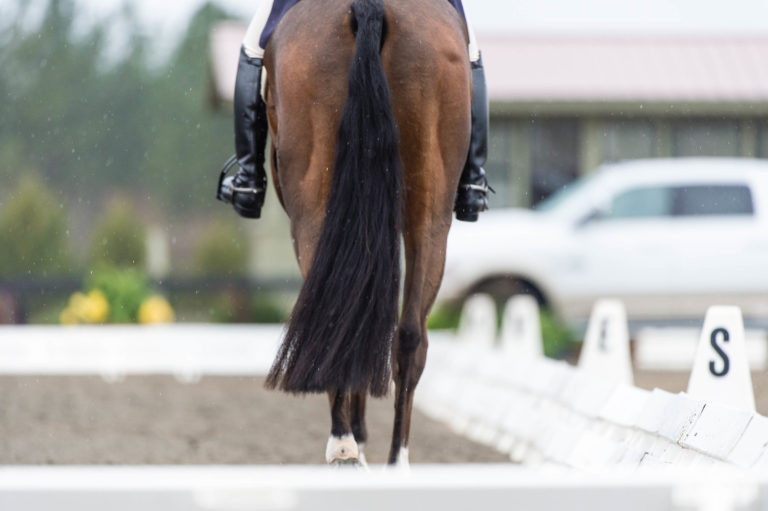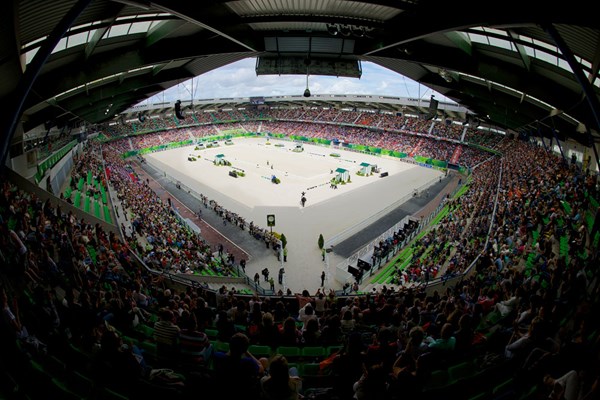
The World Equestrian Games (WEG) is literally the biggest horse show on earth. The 2014 Alltech FEI WEG in Normandy, France, made history of its own this summer as the biggest WEG in the event’s 24-year history. The French hosts of this seventh edition of the FEI’s flagship competition dealt with more athletes, more horses, more officials and more spectators than any previous host has ever done. Not everything went perfectly smooth: massive lines and parking problems became a standard experience for spectators. The location of the WEG Village at a different venue made it impossible for people with tickets for morning and afternoon sessions to get there during the lunch break to shop or eat, and food at the competition venues was more reminiscent of a softball game than a world-championship event in a country renowned for its cuisine. Nevertheless, the caliber of competition made the trip worthwhile for most spectators, even if the organization left much to be desired and did not improve throughout the WEG.
As the first discipline to get underway on August 25, the WEG dressage was a kind of testing ground for the Normandy 2014 organizing committee. One challenge that the WEG organizers could not have predicted was record rainfall in the month of August—rainfall that continued during the dressage competition. The venue for the dressage, d’Ornano Stadium, is a soccer stadium with completely covered grandstands and seating for 20,000 spectators. The audience stayed dry, but the horses and riders were fully exposed to the elements. Several competitors were thoroughly soaked by short downpours that seemed to single out a few unlucky individuals. Unfortunately, the footing and drainage in the stadium were not quite up to the relentless deluge. “Because of the huge amounts of rain which occurred, they worked the footing so that the water would shear off,” explains U.S. dressage team chef d’equipe Robert Dover. The footing was rolled and tamped down to make it firm enough that the water would run off, instead of sink in, where it was unable to drain quickly away. The result was footing that was more concussive than is usually found at modern international venues. “I think that everyone truly understood that it was not an absolutely best-case scenario, but they did the very best they could with what they had,” says Dover. “And the sport still remained hugely positive in the end.”
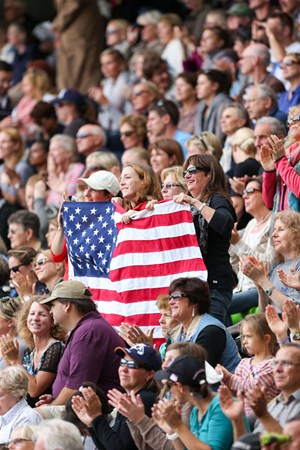
As the German team returned to its position of world dressage dominance and Britain’s Charlotte Dujardin and Valegro danced their way to yet another title, competitor after competitor held nothing back in the team and individual competitions. The dressage at WEG 2014 will be remembered by those who participated and witnessed it as an unforgettable demonstration of talent and skill from the world’s best horses and riders.
The View from X: Laura Graves
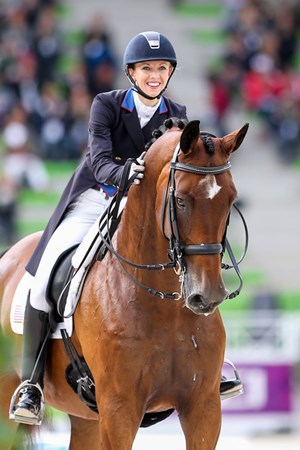
Having gone from obscurity to celebrity in a remarkably short amount of time, American Laura Graves and her 12-year-old KWPN gelding, Verdades, were the undisputed rising stars of this WEG. Graves and the affectionately nicknamed “Diddy” were ultimately the USA’s highest-placed individuals in both the Grand Prix Special and the Freestyle, where they finished fifth in the world. For Graves, the experience in Normandy still hasn’t quite sunk in. “The whole experience was a bit surreal, especially because I still feel the same as before,” she says. “We continue in our daily training and management of the horse, and there is always room for improvement.”
Among her many new and exciting experiences in Normandy, Graves has a couple of standout memories. The first was during the opening ceremonies, where she walked with her fellow American team members in the athletes’ parade. “The first moment that I really became excited for WEG was walking into the opening ceremonies and seeing American flags all over the crowd. I thought, people came to see us! People are excited to see us! That was very special to me.” Another moment that Graves vividly remembers was during her extended canter in the Grand Prix Special. “I completely let go, exhaled and enjoyed the second half of the ride. My horse was so ‘on’ and all I had to do was ride.”
Being on the U.S. dressage team brought with it a measure of pressure for Graves. “I am the type of person who internalizes a lot of things, and the pressure I was under was one of them,” she says. “No one on the team, coaches or otherwise, ever put pressure on me.” Graves remembers leaving the stadium after her Grand Prix test and being greeted by her family, her personal coach, Debbie McDonald, and Dover. “It was a very emotional time for everyone,” says Graves. “It has taken many dedicated people to make my dreams come true and to have all those people there was very special.”
The View from the In-gate: Robert Dover
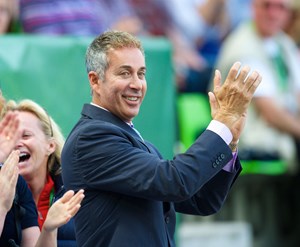
As a U.S. team member and as a team trainer—first for Canada and now for the U.S.—Dover has been to every major championship of the past three decades. One of the most impressive facts of the 2014 WEG for Dover was the high quality of competitors in Normandy. “The results showed that from the teams, all the way down through the eighth and even ninth places, there were many great teams there,” he says. “What we saw were 36 combinations with over 70 percent in the Grand Prix. Teams that didn’t even earn medals had amazing scores that would have meant a gold medal six years ago.” Dover regrets that the fourth-placed U.S. team did not earn a team spot for the 2016 Rio Olympics as it did four years ago in Lexington, where it also finished fourth. The FEI reduced the number of Olympic team qualifications to be handed out in Normandy from four at past WEGs to three. “I feel badly for the teams outside of Europe,” says Dover. “It will be easier to qualify for Rio going through the European Championships. Either Canada or the U.S. is really in jeopardy going forward. I feel confident that America will go to the next Olympics [by qualifying at the 2015 Pan Am Games] but it’s at a price.”
Normandy was Dover’s first major Games as the U.S. team technical advisor. “This was just a fantastic experience with my team,” he says. “It proved that America is absolutely on the right track back to the podium.” Dover was proud of all his team members as well as the additional four combinations who traveled to Europe in preparation for WEG this summer. “I couldn’t be more proud of all the team riders and those who came on the tour. We started with eight riders and horses, all of whom competed successfully. I hope they will all look back on it as a building block back to the podium.” Of Laura Graves’ meteoric rise to the top of the U.S. team, Dover says, “Working with Laura, together with Debbie [McDonald] as her personal trainer, and producing an expedited evolution of that pair, was wonderful. It was a real joy for me and a big boost for American dressage.” Dover says that in addition to her talent as a rider, Graves matches it with her character. “As great as she is as a rider, she’s also just a lovely person. She puts her horse first all the time and looks after him mostly by herself. The rapport between horse and rider is very evident.”
Dover believes that the results in Normandy reflect an overall good performance from the WEG judges. “I think that everything happened, in general, the way it should have happened,” he says. During the team Grand Prix, a total of 127 marks were adjusted by the Judges’ Supervisory Panel (JSP) and a further 60 were changed in the Grand Prix Special. Dover was disappointed that the JSP didn’t adjust a couple of anomalous scores on Steffen Peters’ and Graves’ tests, and he believes the role of the JSP needs to be refined to address that kind of oversight in the future. “They only do counting errors,” he says in reference to the fact that the JSP can correct only objectively measurable mistakes, such as the count in tempi changes. “It’s problematic because I think what they need to do is further define their jobs in order to ensure that the very best results are produced from each of the test sheets.” Nevertheless, Dover will remember the 2014 WEG as the place where the world witnessed “a fantastic quality of competition.”
The View from the Judge’s Booth: Lilo Fore
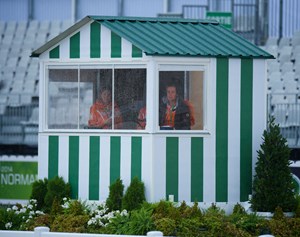
The experience of being one of the seven judges positioned around the perimeter of the WEG arena and deciding who would win the medals was momentous for Liselotte (Lilo) Fore. “I was very proud, excited and honestly amazed that I was on the first list for judging at WEG,” she says. “My life as a national judge started in 1974 and as an international judge in 1990,” she explains, “so I am no spring chicken to the world of dressage. I have judged many CDIs, but barely at all in Europe, so I did not know most of these amazing horses. I had only had my five-star FEI judge rating for a year.” As the long list of potential jury members became a short list and then a final list of judges for Normandy, Fore was both nervous and excited to see that she had made the cut. She says that she experiences the same nerves as a judge that she used to have as a competitor. “I always have some butterflies which subside as soon as I am in that box and see the first horse coming down centerline.”
Fore prepared for the responsibility of judging at WEG by being on several European juries earlier in the season. “I had the good fortune that some of the CDIs here in Europe invited me to judge this year. It broadened my view and gave me the confidence that judging and doing a good job are still the main focus.” Fore found it a new and slightly intimidating experience to be giving out scores that approached the 80s. “It is a little scary when one sits in that box and you get to say a lot of eights and nines and then the mysterious 10. Wow, what a thrill it is, but then you wonder where that score is going to end up.”
Judging the WEG team competition was a marathon, with 49 horses the first day and 51 the second. “Amazingly, the time went by unbelievably fast as we were so busy,” says Fore. “We had no time to worry about anything except the riders in front of us.” Fore’s judging position for the team competition was at the letter F. The positions at F and K are used only at major championships, where the jury has seven members, and Fore had no experience judging from that spot. “It did worry me a little, to be honest,” she says. “The one thing I reminded myself of was that I have taught riders from all locations around the arena.” Fore is proud of the results that she and her colleagues produced throughout the WEG dressage competition. “I believe we had an awesome panel of judges. We truly judged as a team, and the camaraderie among us never wavered.” As the American judge on the panel, Fore says she was proud to represent the U.S. and to witness the strong performance from the U.S. team. “Our team did more than was expected. We were fourth, and that was exciting to see.”
The View from the FEI: Trond Asmyr
WEG 2014 was Trond Asmyr’s second world championship in his role as FEI dressage director. A rider and FEI dressage judge himself, he was impressed by the incredible sport that took place in Normandy and by the record number of teams and individuals. “The numbers are a clear indication of the strong, positive development we have in dressage around the world,” says Asmyr, who was particularly excited to see a proliferation of “light, harmonious riding. This is a really good sign for the future,” he says. Even though the extraordinarily high scores in the WEG dressage competition were not surprising given the results at other European events over the past year, Asmyr still found it impossible to single out one or two moments from the competition as standing out from the rest. “There were just so many highlights,” he says.
Record Entries and Historic High Scores in Para-Equestrian Dressage
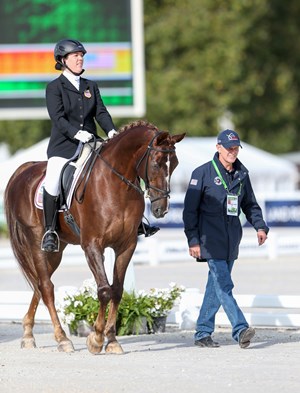
The 2014 Alltech FEI World Equestrian Games (WEG) were only the second WEG to include Para-Equestrian Dressage, though it’s been an FEI discipline since 2006. With 33 nations and 100 horse-and-rider combinations competing, Normandy 2014 not only exceeded the numbers from Para-Dressage’s inaugural WEG appearance in Kentucky four years ago, it was the biggest Para-Dressage competition in the history of the discipline. Scores in both the team and individual competitions exceeded previous World Championship scores across the board.
The U.S. Para-Equestrian Dressage Team in Normandy included several younger human and equine athletes who showed promise for the future. The veteran of the team, two-time Grade II Paralympian Rebecca Hart, was riding a new partner, the 12-year-old Danish Warmblood mare Schroeter’s Romani. The U.S. team also had the youngest competitor in the WEG Para-Dressage competition, 16-year-old Sydney Collier, who competed in Grade Ib with Willi Wesley, a 14-year-old warmblood gelding. Grade IV athlete Susan Treabess and the 9-year-old PRE stallion Kamiakin, and Grade Ia athlete Roxanne Trunnell on Nice Touch, a 19-year-old Dutch Warmblood mare, rounded out the team. In addition, the U.S. sent one individual rider, Angela Peavy, who rode the 8-year-old Trakehner gelding Ozzy Cooper in the Grade III division.
The WEG Para-Dressage competition took place at the beautiful and centrally situated Prairie Racecourse in the city of Caen. Extremely wet weather during the team competition discouraged spectators, whose grandstand was completely exposed to the rain. By the freestyle competition on the last day of the Para-Dressage, sunny skies brought out bigger crowds, though the stands were still far from full. The WEG scheduling was problematic for spectators who wanted to take in both the dressage competition and the Para-Dressage, since both disciplines took place concurrently and at different venues that were not walking distance apart.
“Although it is positive to have dressage and Para-Dressage at the same time, this also limits the possibility for dressage fans to see both,” says FEI dressage and Para-Dressage director Trond Asmyr. “We saw fantastic interest and spectator numbers two years ago in the London Paralympic Games, where we had more than 10,000 spectators for every session. We have not received the report of the numbers in Normandy yet, but it was clear that we did not reach the same level of interest.” Asmyr says the FEI continues to work to raise the public profile of Para-Dressage. “We are confident that we will slowly succeed,” he says.
Europe Dominates
If the scores exceeded expectations, the nationalities of those who won the team medals were not at all surprising. Great Britain, led by the world’s most decorated Para-Dressage athlete, Lee Pearson, successfully defended its title from Lexington, Kentucky, winning gold. Pearson swept the individual competition, leading the field by at least two percentage points in each test. The team from the Netherlands, aided by Grade II individual and freestyle gold medalist Rixt van der Horst, took team silver. Germany, having won silver in 2010, settled for bronze; their strongest individual was Grade IV rider Michele George, who won individual and freestyle gold.
As with the able-bodied dressage taking place a couple of miles away at d’Ornano Stadium, the countries that rose to the top in the team Para-Dressage competition were those that had at least one star competitor to lead the team into the medals. The U.S. team surpassed its results from 2010, with an overall team score of 407.042, compared to 398.066 four years ago, but a final ranking of 11th out of 17 teams was lower than their seventh place (out of 16 teams) in Lexington. The only North American Para-Dressage rider to win medals in Normandy was Canada’s Lauren Barwick, who won individual bronze and freestyle silver in the Grade II competition. But even Barwick was unable to bring the Canadian team close to the podium; Canada finished eighth.
Promise for the Future
For Hart, the U.S. team member with by far the most international experience, Normandy was a building block toward the 2016 Paralympic Games in Rio de Janeiro. Schroeter’s Romani shows great potential, but is still green in the show ring. “We are a new partnership, and you don’t always have the trust yet,” said Hart of her horse’s performances in Normandy. “We have come a long way since November and to be in France representing our country is such an honor. She is a talented horse, and I look forward to continuing our partnership.”
Hart’s seventh-place finish in the individual test with 67.486 percent was good enough to move her on to the freestyle, which, for the first time, was limited in entries to the top third of individuals. Riding to her brand-new Journey freestyle created by Marlene Whitaker, Hart had a very exuberant, but not mistake-free, performance to finish seventh with 65.4 percent.
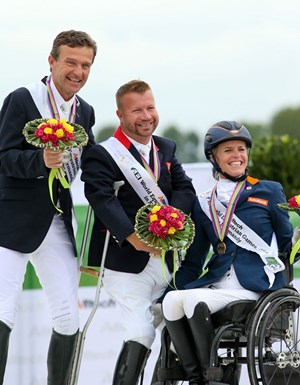
The highest U.S.-scoring rider in Normandy was team newcomer Trunnell. Riding Nice Touch in the Grade Ia division, Trunnell achieved an impressive score of 69.435 percent and eighth place in the individual test. She improved one placing in the freestyle to finish seventh. “Touché has always been an amazing horse to ride, but to throw her into international competition at 19 was a little bit nerve-wracking,” says Trunnell. “I expected to make it through my tests, but I had no clue my girl and I were going to be the highest-scoring members of the USA team.”
Trunnell has now retired Nice Touch from competition. As with all the U.S. Para-Equestrian athletes, the challenge to find a quality horse and the finances to make the journey possible is a big one. Trunnell hopes for the opportunity to aim for the next Paralympic Games in 2016 with the right horse and some sponsorship support.
Collier earned the second-highest score for her team, 68.103 percent in the Grade Ib individual test. Ninth place left her just out of the freestyle, but Collier has a long and bright future ahead of her. “This is my first overseas competition and World Championship, so this has been an incredible experience,” she said after her team test.
The fourth U.S. team rider, Susan Treabess, faced some challenges in the ring with her young stallion. Her best score was 65.833 percent in the Grade IV team test. “This is a building experience,” said Treabess of the competition in France. “My horse is young and he’s a stallion. It’s just a matter of experience.” Even though she was riding as an individual, Peavy competed in the team test, where she earned her best result of the WEG, 65.421 percent and 10th place.
The U.S. Para-Dressage Team missed out on a qualification for the 2016 Paralympics, as only the three top teams earned spots for Rio. However, there will be more opportunities for the U.S. to qualify a team or individuals through the Paralympic rankings over the next two years.







